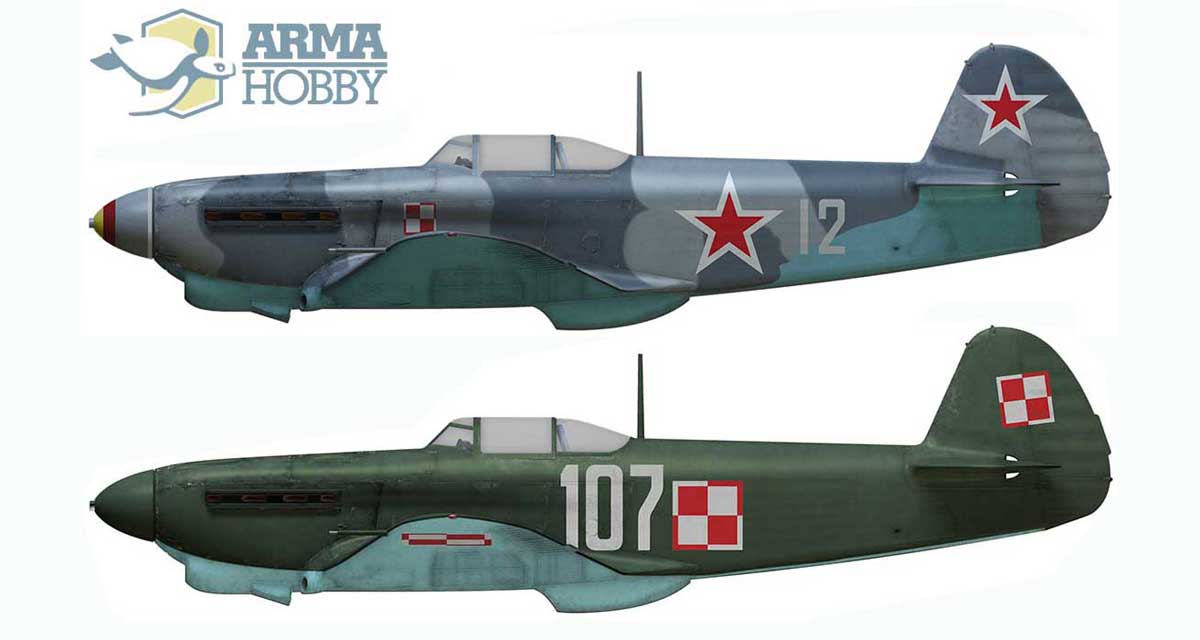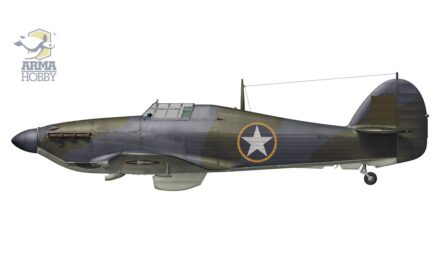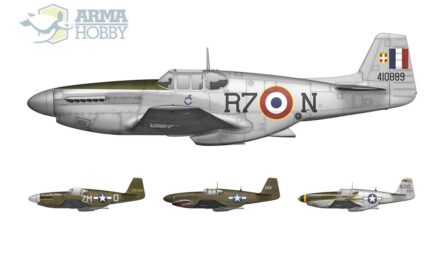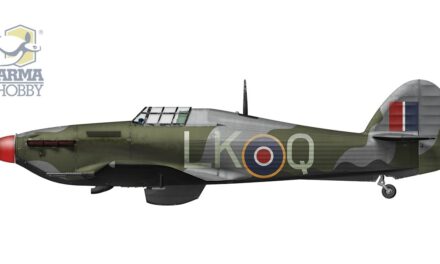The 1st Fighter Aviation Regiment “Warszawa” was the first aviation unit of peoples’s Polish Army formed soon after the creation of the, so called, “Berling’s army” had started. Its combat history is relatively short – less than nine months of fighting in the Eastern Front, when pilots, flying obsolete fighters, flew missions which were not too intensive nor very successful.
When we compare the “Warszawa” Regiment successes with the achievements of Polish Air Force in the United Kingdom, they are not astonishing. Why, therefore, the history of Polish pilots flying Yakovlev’s fighters electrifies Polish aviation amateurs so much?
The Beginnings
Polish army in the USSR, also known as people’s Polish Army, was created in the spring of 1943 under the inspiration of Stalin. The Soviet leader used Polish communists to create his own Polish army that could be counterweight for Polish Army in the west who were loyal to Polish legal government in London. Regadless of political motives (there was only one actually – to make Poland dependent from the USSR), the army was the only hope for thousands of Polish citizens, who had been deported to the Soviet Union between 1939 and 1941, to return to their country.
However, Polish Army in the USSR was not recognised by the United States and the United Kingdom until June 1945 when both countries decided to recognise communist authorities loyal to Stalin as a legal government and withdrew support for the legal government in London.
Although the adjective “people’s” is widely used it was not official nor integral name and that is why in this article it is written with small letter.
Student pilots of the 1st Regiment training group with the Soviet instructor (first left). The others are (from left):unknown, PFC Leon Krempa, PFC Jerzy Czerny, PFC Krzysztof Donigiewicz, PFC Wacław Pietkun, Sgt Maj Sergey Danovskiy and Lt Jan Małaszewicz. The airmen are standing in front of UT-2. The turn of 1943 and 1944
From Moscow to Berlin
The 1st Fighter Aviation Regiment was formed at the beginning of July 1943 in Grigoyevskoye, a village between Moscow and Ryazan, near Syeltsy, where Polish 1st Infantry Division was being formed. At the beginning it was an Independent Fighter Flight, being part of the 1st Division. But in August 1943 the order changing the Flight into a regiment was issued.
Forming an aviation unit was quite a challenge for the Polish Army staff officers – training of infantry units takes weeks or months but pilot training can take years. The biggest problem was that there were not any Polish airmen in the USSR. Most of them were murdered by Soviets during the mass purge known as the Katyn massacre, and those who survived left the USSR and went straight to Great Britain or were evacuated to Persia together with Polish Army led by Gen. Władysław Anders
During the search conducted in kolkhozes, sovkhozes, factories, and saw mills around the USSR only few pilot students, two NCO pilots and several ground crew personnel were found. There was also one officer but, unfortunately, he was an air observer, not a pilot.
So it was necessary to look for Polish pilots serving in the Voyenno-Vozdushnye Sily. However, that was also a difficult task, because during the Great Purge in 1937-38 NKVD had murdered 111,000 Soviet citizens of Polish ancestry and further 29,000 were sent to gulags. So an “acting Pole” could have been anyone who had Polish ancestors. Those who were transferred to Polish army changed their names – Iosif became Józef, Ivan – Jan, Vladimir – Włodzimierz and so on. The authorities even managed to change such an unusual names as Vsevolod who became Wiesław.
The rest of personnel were Soviet soldiers, who did not have any Polish connections, transferred to the Regiment in Grigoyevskoye from Soviet units.
Several volunteers were chosen for flying training – these were Poles and Jews who were Polish citizens before the war as well as Russians of Polish ancestry. Young Poles were usually victims of mass deportations from the Eastern Borderlands to the USSR that took place after Soviet invasion of Poland in 1939. They regained freedom after Sikorski – Maisky treaty but did not join Polish Army in the USSR led by Gen. Anders. Some of them spent some time in Soviet gulags and prisons and some of them had been forced to serve in the Red Army.
There were also women in the 1st Regiment – they were clerks and even were part of ground crew working as parachute riggers, engine and airframe fitters. Some of those brave women later married pilots and made first aviation marriage couples in the people’s Polish Army.
One of the first Yak-1b in the Regiment No 11 (s/n 11150) in Grigoryevskoye in the summer or autumn 1943
At the beginning, both pilots and ground crew underwent elementary training. Soviets sent to Grigoryevskoye a special unit of flying instructors from the Moscow Military District whose task was to train pilots in elementary and advanced (fighter) flying. After finishing their work, most of the them went to other units but some stayed in the Regiment.
The pilot training course took place it Grigoryevskoye (and later on three other auxiliary airfields) and the students were divided into three groups. The first one was created at the end of July 1943 and finished full training (both elementary and advanced) in January 1944. The second group started training in August 1943 and finished full training in the middle of May 1944. The third group started the course in October 1943 and by May 1944 they finished only a elemantary course. At that time the pilot of the 1st Regiment could have three times less flying hours than a pilot of the Polish Air Force in the United Kingdom. But there was no time for further training…
In the second half of April 1944 the Regiment was re-formed according to a new, expanded type of Soviet fighter regiment, 015/364, which included 241 crew, 40 combat aircraft, 1 training aircraft and 1 liaison aircraft. Such unit had three flights of 12 aircraft and a headquarters section of 4 aircraft.
In June 1944, the Regiment moved to Gostomel airfield near Kiev in the wake of the 1st Corps of Polish Army in the USSR (created after expansion of the 1st Infantry Division and soon after transformed into the 1st Polish Army in the USSR). The pilots of 1st, 2nd and 3rd Flights were improving their skills in flying, dog fighting and strafing on the proving ground. The pilots of the third training group (who temporary created an unestablished 4th flight) were finishing their training.
In August 1944 three flights and the Headquarters’ section of the 1st Fighter Aviation Regiment moved from Gostomel to the front with stopovers in Włodimierzec in the Volyn Region (the first landing ground within Polish pre-war territory, currently in Ukraine) and Dys near Lublin. On the 19th August the unit finally reached their destination – Zadybie Stare airfield near Garwolin, south-west of Warsaw. The fourth flight stayed in Gostomel to finish their flying training course. Later its pilots arrived in Zadybie Stare but only four of them stayed with the Regiment. The rest were sent to the rear unit.
On the 23rd April 1944, the 1st Regiment flew its first combat mission – fighter escort of Il-2 attack aircraft strafing targets near Warka. Later pilots fought over bridgeheads near the town, they were supporting army units liberating Praga (a district of Warsaw) in 1944 and the rest of Warsaw in January 1945. Contrary to information that can be found in the propaganda books published in communist times, the “Warszawa” Regiment did not give much support to Polish Home Army units during the Warsaw Uprising. It is a little known fact that the 16th Air Army Headquarters issued the order forbidding the unit from flying over Warsaw until the 10th September.
Later the Regiment took part in combats over Pomerania, in the battle of Kolberg (now Kołobrzeg) in March 1945, and fought over the Baltic coast in March and April 1945. Finally, in April and May 1945, it took part in the Battle of Berlin.
Pilots’ duties were Il-2 aircraft escort missions, attacking ground targets, tactical reconnaissance (visual and photographic), defensive patrols and interceptions.
During the war the 1st Fighter Aviation Regiment, together with the 2nd “Krakow” Night Bomber Regiment and the 611th (later renamed as the 3rd) Attack Regiment established the 1st Mixed Aviation Division, renamed in November 1944 to 4th Mixed Aviation Division.
A group of student pilots standing by a very interesting Yak-7 in Volosovo (a sattelite airfield of Grigoryevskoye) in April 1944. The aircraft in the photo is a late version of Yak-7B, rebuilt to two-seater without radio.
The Aircraft
Initially pilots flew Yakovlev UT-2, elementary training, two-seater aircraft. In September 1943 the Regiment received first Yak-7 two-seater aircraft. These were used as transfer aircraft between UT-2 and Yak-1b. In December 1943 there were seven Yaks-7 and in April 1944 – three. When pilots finished their training in 1944 two-seaters became needless and from August 1944, when the Unit went to the front, until the end of the war there was only one Yak-7 which was used by Division’s flying inspector to check pilots’ abilities.
Also in September 1943 the Regiment received their first Yak-1bs. Those were “second hand” aircraft and were worn out after service in the VVS. In October 1943, and in February and March 1944, unit received further, this time factory fresh, aircraft. Between April and June 1944 there were 43-45 aircraft. When the 1st Fighter Aviation Regiment moved to Gostomel it received another factory fresh aircraft and gave old ones away. However, until the end of the war, the unit did not receive other new aircraft. Altogether during the war, including pilots’ training and combat, the Regiment received 60 Yaks-1b.
Yak-1b No 12 (s/n 12181) – Oleg Matveyev’s plane, who was Regiment’s chief aerial shooting instructor. The photo taken in Bydgoszcz in May 1945 after Matveyev’s death (he died in March 1945 flying Yak-9).
Another type used by the Regiment in combat were Yak-9D, M and T fighter aircraft. According to unconfirmed data, the first aircraft (or maybe first two aircraft) arrived in April 1944, while the unit was still undergoing its training, to make pilots familiar with the type. They were probably used by mid-August 1944. The first Yak-9s to be used in combat arrived in December 1944 – those were four Yak-9Ds. One of them was flown for the first time by Capt Oleg Matveyev on the 28th December 1944.
On the 18th January unit received another batch and on the 26th January the last one during the war. In total the 1st Regiment regularly used 25 Yak-9s since the 19th January. That type was preferred by pilots – twice as many missions were flown on Yak-9s than Yak-1bs in the period in which both were available.
Commanding Officers
Regiment’s first CO was Maj Wacław Kozłowski, a Soviet citizen of Polish ancestry who had been flight commander in the 648th Bomber Aviation Regiment. On the 10th August, only a few weeks after becoming the CO, he lost his life in a flight accident with one of training instructors, Senior Lieutenant Anatoliy Korovin.
Yak-1b No 12 (s/n 12181) – Oleg Matveyev’s plane, camouflage and markings reconstruction as in May 1945. Artwork by Zbyszek Malicki.
On the 16th August 1943 Capt Tadeusz Wicherkiewicz – a pre-war Polish Army officer, a glider pilot and a tourist pilot, who only started military pilot training in Grigoryevskoye, became the new CO. It was a political decision as Wicherkiewicz was a avowed communist and there were no other candidate. Soon he was promoted to Major.
It is hard to describe who he really was. His rich brag sheet lived to see a biography (titled “Cztery zakręty”) where the introduction reads:
“Pre-war airman, a soldier of September 1939 campaign – a prisoner of Soviet camps – a manqué victim of Katyn massacre – an officer of the Anders’ Army – later Berling’s Army – German Prisoner of War – a prisoner of Soviet lagers – secret collaborator of the Department of Security – a person with two death sentences: one sentenced in the West and one by communist courts in post-war Poland.”
In January 1944 Wicherkiewicz was removed due to poor organisation and training progress. Originally he was supposed to leave the unit but finally he stayed as a commander of the 3rd flight. Then, for some time, Maj Nikolay Buyevich (a Russian of Polish roots) was acting CO. But finally, at the end of February 1944, Lt Col Ivan Taldikin became a new CO. He was a fighter pilot to the bone with a long frontline service with air victories. He successfully managed to prepare unit for combat and then led it in operations. Unfortunately this much liked and deserving commanding officer lost his life in an air accident in March 1945. He was replaced by Capt Vasiliy Gashin – one of instructors from Grigoryevskoye in the summer 1943. He was a very good pilot, although not as experienced and popular as his predecessor. He led the unit until the end of war.
One of the first Yak-9D delivered in the first batch. Photo taken in the winter of 1944-45.Unfortunately there are not any markings nor tactical numer.
Zwycięstwa
Podczas działań bojowych na Jakach-1b piloci 1 PLM „Warszawa” nie odnieśli żadnych zwycięstw powietrznych. Spotkania z Luftwaffe należały zresztą do rzadkości i zwykle kończyły się bezskuteczną pogonią lub odpędzeniem nieprzyjaciela. Ich łupem wielokrotnie padły za to cele naziemne: pojazdy, pociągi oraz kolumny wojsk.
Sukcesy przyszły dopiero po przesiadce na Jaki-9. Pierwszym zapisanym na koncie pułku było zniszczenie na ziemi zaparkowanego na polowym lądowisku koło Piły Junkersa 52, czego dokonać mieli 14 lutego 1945 r. kpt. Oleg Matwiejew (Jak-9 nr 86, nr fabryczny 3215386) oraz por. Witold Gabis (Jak-9 nr 68). Według najnowszej wiedzy był to samolot zapewne niesprawny już wcześniej, świadomie porzucony przez Niemców.
Zwycięstwa powietrzne przyszły dopiero w ostatnich dniach wojny, podczas operacji berlińskiej. Częstotliwość spotkania z nieprzyjacielem w powietrzu raptownie zwiększyła się i piloci „Warszawy” regularnie widywali Focke-Wulfy 190, Messerschmitty 109, a nawet odrzutowe Messerschmitty 262.
Wielkim dniem dla pułku okazał się być 19 kwietnia 1945 r. W czasie całodziennych lotów nad Brandenburgią aż pięciu pilotom zaliczono zestrzelenie Focke-Wulfów 190. Byli to: ppor. Wiktor Kalinowski (Jak-9 nr 87), ppor. Wsiewołod Bobrowski (nr 68), kpt. Władimir Bajow (nr 32), ppor. Julij Kozak (nr 93) oraz por. Anatolij Szyrokun (nr 4, nr fabryczny 4115304).
Nazajutrz, 20 kwietnia, w walce powietrznej kolejnego Focke-Wulfa uszkodził chor. Stefan Łazar, lecąc na Jaku-9 nr 58.
Kolejnym pełnym sukcesów dniem był 25 kwietnia. Zestrzelenie trzech Focke-Wulfów 190 zameldowali: ppor. Nikołaj Chaustowicz (Jak-9 nr 100), ppor. Wiktor Kalinowski (nr 87) oraz chor. Juliusz Szwarc (nr 101).
Ostatnim pilotem 1 PLM, któremu zaliczono zwycięstwo powietrzne, był por. Aleksandr Wierbicki, który 1 maja 1945 r. zgłosił Messerschmitta 109 (na Jaku-9 nr 68; tym samym samolot ten stał się najbardziej utytułowaną maszyną ludowego lotnictwa, mając na koncie dwa zestrzelenia powietrzne i połówkę samolotu zniszczonego na ziemi).
Łącznie pilotom zaliczono zestrzelenie dziewięciu samolotów nieprzyjaciela oraz uszkodzenie jednego, a także zniszczenie jednej maszyny na ziemi.
Victories
While flying Yaks-1b pilots of the 1st Regiment did not achieve any aerial victories. At that time it was hard to find Luftwaffe in the air and if the pilots met them they only unsuccessfully chased enemy planes or just drove them away. On the other hand multiple ground targets – trains, vehicles or marching German soldiers fell prey to the Regiment’s pilots.
Victories against enemy aircraft only came when Yaks-9 arrived. The first one was Ju 52 parked on the landing ground near Schneidemühl (now Piła) destroyed on the 14th February 1945 by Capt Oleg Matveiev (Yak-9 No 86, s/n 3215386) and Lt Vitold Gabis (Yak-9 No 68). According to latest information that Ju 52 was unserviceable and abandoned by Germans.
Victories in the air only arrived at the end of the conflict during the Battle of Berlin. Pilots more often met enemy aircraft in the air – Focke-Wulfs 190, Messerschmitts 109 and even German jet fighters Messerschmitt 262.
The most successful day was the 19th April 1945. During combat missions over Brandenburg five pilots were credited with Fw 190 fighters. Those pilots were: 2nd Lt Viktor Kalinovskiy (Yak-9 No 87), 2nd Lt Vsevolod Bobrovskiy (Yak-9 No 68), Capt Vladimir Bayov (Yak-9 No 32), 2nd Lt Yuliy Kozak (No 93) and 2nd Lt Anatoliy Shirokun (No 4, s/n 4115304)
On the 20th April, Ens Stefan Łazar (Yak-9 No 58) damaged another Focke-Wulf.
The 25th April was another successful day for the Regiment. 2nd Lt Nikolay Khaustovich (Yak-9 No 100), 2nd Lt Viktor Kalinovskiy (Yak-9 No 87) and Ens Juliusz Szwarc (Yak-9 No 101) claimed three Focke-Wulfs.
The last pilot credited with a victory was Lt Aleksandr Verbitskiy who on the 1st May 1945 claimed one Messerschmitt 109 while flying Yak-9 No 68, which became the most successful aircraft in the unit with two aerial victories and a half of a plane destroyed on the ground.
A total of nine German aircraft were destroyed in the air, one damaged and one destroyed on the ground.
The pilots watching the ground crew at work with Yak-9M No 35. The photo probably taken in March 1945 in Märkisch Friedland (now Mirosławiec). In the background Yak-9 No 44 and a plane with illegible number. On the left Yak-9D No 4.
Casualties
First pilots lost their life during training in the Soviet Union.
The first one was the first CO – Maj Wacław Kozłowski, who died with the instructor, Senior Lt Anatoliy Korovin, on the 10th August 1943. Their UT-2 hit the aerial mast in Syeltsy and crashed in the woods.
On the 17th November PFC Ryszard Borzykowski and his instruktor Junior Lt Ivan Bondar were killed in another UT-2 accident.
On the 5th May 1944 in Zhytovo, during the control flight on Yak-7 (s/n 0479) with PFC Jerzy Czerny and Senior Lt Vsevolod Anikin on board, the engine set on fire which forced the crew to make force landing. The plane landed correctly but both pilots were severly burned. Czerny died two days later and Anikin survived.
Another two fatal accidents involved Yak-1b fighters. On the 17th May 1944 Senior Lt Andrey Gavilov crashed his plane (s/n 40155) when he was making aerobatics on low altitude. On the 25th July 1944 Ens Jan Grabarz lost his life near Gostomel airfield, when his plane crashed on the hangar during the training flight.
On the 5th August 1944 Maj Zygmunt Kisielew crashed UT-2 in Gostomel when returning from liaison flight.
The first combat casualty was Maj Tadeusz Wicherkiewicz who went missing on the 24th September 1944 when his plane was hit by the anti-aircraft artillery over Warsaw. He managed to leave his mount on the parachute but the wind dragged him to German occupied territory. He was taken prisoner.
On the 13th February 1945 2nd Lt Iosif Gostiuminskiy (Yak-9 No 53, s/n 371553) was shot down during the combat with Messerschmitts 109 over Ogorzeliny village near Chojnice)
On the 14th February 1945 German flak shot down Capt Matvieyev’s Yak-9 No 86 (s/n 3215386) which crashed near Piła (it was the same mission when Matvieyev attacked Ju 52 on the ground)
On the 15th March, during the patrol over Kolberg Ens Aleksander Broch (yak No 81, s/n 3315381) was reported missing. Unit soon learnt that he was killed.
On the 16th March 1945, near Bad Polzin (now Połczyn-Zdrój), Lt Col Ivan Taldykin crashed his plane during the escort mission of Il-2 aircraft. The accident was caused by pilot’s error – in poor visibility he flew too low and hit the ground. His plane was Yak-9 No 15 (s/n 3415315).
On the 19th April 1945 in Berneuchen (now Barnówko) the Regiment lost another pilot. Ens Roman Wierzchnicki hit the tree after he turned too early while taking off. He was flying Yak-9 No 80 (s/n 3915380).
Three days later another tragedy struck the unit in Berneuchen. While returning from reconnaissance mission Lt Anatolyi Shirokun was making a half-roll on 400 metres but the plane lower the nose and hit the ground. It burnt completely. The examination of the wreckage found that the steering cables had broken.
Apart from fatal accidents there were also other, minor mishaps which did not caused any casualties. They were caused by pilots’ errors, enemy actions or malfunctions.
During the war the 1st Fighter Aviation Regiment lost 11 pilots and student-pilots and three Soviet instructors who taught Polish pilots.
Yak-1b No 107 (s/n 01189) in the Polish Army Museum in Warsaw. Photo taken in January or February 1946. During the war it served in the 1st Fighter Aviation Regiment – its tactical number was 1. After the war it was sent to the maintenance unit where it was repainted and sent back to the Regiment where it received a new tactical numer – 107. In January 1946 it was presented to the Museum.
The most interesting of boring regiments
The 1st Fighter Aviation Regiment was not involved in combat much. During 8.5 month of combat service pilots made just over 1400 combat sorties. It is really not much, especially when we compare it with No 318 Fighter Reconnaissance Squadron “City of Gdańsk” which only in February, March and April flew 1320 sorties. But we must remember that No 318 squadron was more less half a size of the 1st Regiment but had similar tasks – tactical and photo reconnaissance and attacking ground targets.
At the time when Polish squadrons in the United Kingdom used modern, fast, heavily armed fighters made of metal and equipped with gyro gunsights, the pilots of the Regiment flew fighters made of fabric and plywood, poor armament, noisy radio equipment. Their training was also worse than that of Polish pilots in the West.
However, it is hard to call the Regiment a Polish unit . There were more Polish pilots in the 1st Regiment than in any other air combat units of people’s Polish Army but the percentage of Soviet personnel was still very high. For example, only two of pilots who claimed victories were Polish citizens before the war: Stefan Łazar and Juliusz Szwarc. The former was a Pole and the latter was a Jew. Bayov and Shirokun were Russians, Bobrovskiy, Khaustovich, Kalinovskiy and Verbitskiy – Soviet citizens of Polish ancestry. None of them spoke Polish before arrival to the Regiment. They started learning this language in the unit.
Wicherkiewicz, who was quickly sacked, was the only wartime commander of the regiment and flight commanders of Polish citizenship. The rest were Soviets.
Yak-1b from 1st Regiment repainted with post war camouflage and Polish Markings during overhaul in late 1945. Aeroplane donated to the Polish Army Museum in Warsaw. Artwork by Zbyszek Malicki.
Most of pilots’ victims were German fighters in attack versions which were easier prey than regular fighters. They were heavy armed but less agile. Their pilots were focused on ground targets so Yak pilots had easier task.
It is possible to write detailed monographies of the Regiment, re-write and make comments on combat diary, give information who, when and a detail of a plane used to make reconnaissance mission or to attack enemy units. But this is not the most interesting part of this Regiment’s history.
The most interesting part are histories of people who made that unit: commanders, pilots, ground crew; Poles, Jews, Russians and other nations living in the Soviet Union. Their histories could only be told, without propaganda, after 1989 when censorship stopped interfering when authors wanted to show the horrible fate of people who had lived under the murderous Soviet regime. It was also possible to show what aims had those who served in people’s Polish Army.
It is fascinating to see how such a diversified staff in unfavourable conditions were able to create a fighter regiment that fulfil its tasks and became a nucleus of people’s Polish Army Air Force.
That is why I would like to suggest to read further texts, other than popular and much liked (although filled with propaganda) memoirs of Edward Chromy and Medard Konieczny.
Especially, published a few years ago, thin but most interesting memoirs of Kazimierz Rutenberg „Kierunek był jasny”.
On the other hand Polish quarterly magazine „Lotnictwo z Szachownicą” published memoirs of Jakub Lewitin, another pilot who served in the Regiment.
The above mentioned „Lotnictwo z Szachownicą” and two other magazines – „Gapa” and „Aero” have published a lot of articles about other pilots – Vsevolod Bobrovskiy, Aleksander Broch, Czesław Chochorowski, Jerzy Czownicki, Karolina and Jakub Lewitin, Oleg Matveyev, Viktor Kalinovskiy, Viktor Poruchnichak, Zygmunt Rejngold and Kazimierz Rutenberg. All contain a lot of unique photographs.
I strongly encourage the Reader to find and read these articles.
You may be interested in:
Wojciech Zmyślony, electronics engineer, enthusiast and researcher of the history of the Polish Air Force, especially of the 1st Fighter Aviation Regiment "City of Warsaw" and the 318th Fighter-Reconnaissance Squadron "City of Gdańsk". The founder of www.polishairforce.pl, the author and co-author of more than 100 articles and several books.
This post is also available in:
 polski
polski















